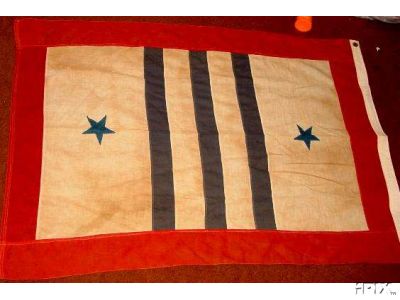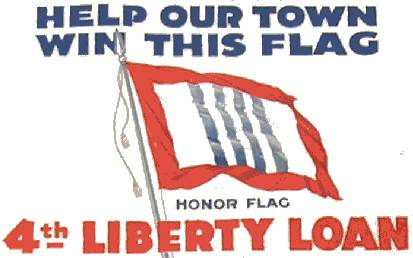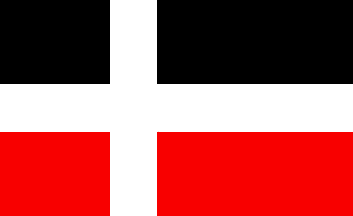
Last modified: 2010-02-27 by pete loeser
Keywords: ufe | unidentified flags |
Links: FOTW homepage |
search |
disclaimer and copyright |
write us |
mirrors
Identification Key:
This burgee flag was found as an enamel tie-clip: a white triangular field, blue
saltire, with a blue star in the hoist triangle.
Bob, 5 March 2003
This is almost certainly, the Manchester Yacht Club (Mass., US):
http://www.manchesteryachtclub.org/
Jan Mertens, 25 June 2005
Here is a flag from an illustration of London river Thames in ice in the XIXth century. Here is the text around the picture: "A frost fair on the Thames. Before Sir Joseph Bazalgette built the embankments in the 1840s the Thames was wider, shallower and flowed more slowly. Thus it sometimes froze over in cold winters and quite large fairs could be held on the ice." What is this flag?
Thierry Gilabert, 30 December 2003
To me this appears to be simply a rather crudely depicted British Red Ensign.
Michael Faul, 26 June 2006
From an old Japanese plate dated 1876. I can't identify this country (Malatee). It is probably related with Bengala (flag of the nawab of Bengala?)
Jaume Ollé, 17 Jan 2000
If this is what I think it is, Malatee is the old name for Malatya, a city high in the mountains of central Turkey. It was the site of an infamous massacre of Armenians during or around the time of World War One. Could this be where the flag is from?
James Dignan, 26 August 2003
I cannot give an exact answer but most probably this flag has nothing to do with Malatya. First, Jaume Ollè says that it is from an "old Japanese plate". It is not so likely a Turkish symbol is on such an item in year 1876. Second, although I cannot say that I'm an expert in Turkish symbolism, I can say that the flag does not "seem to have" Turkish figures. Third, in Turkey and in this part of the world, there is no a strong flag tradition like in the west. In the Ottoman Empire, I know that there are flags of some distant administrative units. I don't think that a city flag existed. Perhaps it can be claimed that it is the symbol of a religious or social group in Malatya (or in all Anatolia). But it won't be far than speculation. The date of the plate (1876) and that of the so-called "Armenian massacre" (1895) are not far away. Did you mention it because you think that there can be a relation or just to give information about the city? In short, my opinion is that Bengala or another far- eastern origin is much more probable.
Onur Özgün, 16 February 2004
I've done a little more searching in an old encyclopedia to look for other possibilities, and I note a Malate in the Phillipines, which is now a central part of the city of Manila. I suppose it's possible it might be connected with that...?
James Dignan, 16 February 2004
I notice that on the fifth page of the 1847 World National flag Japanese manuscript forwarded to me by William Garrison ( http://www.geocities.jp/r7321n/zx/8178.jpg ) it shows shows a flag (row 2, flag 3) that is very much like this one. Can anyone read the text accompanying it?
Rob Raeside, 17 January 2010
The flag is identified as from "Persha." The first flag in that row is identified as a flag of Malaten, which was located in West Coast India and was mostly a Musulim area at that time. According to the old Japanese book, Malaten revolted against the British East India Company with support of Afghan Shir in 1707. I am not sure if the place name Malaten is still used in India.
Nozomi Kariyasu, 17 January 2010
I don't know where you got the information about the revolt against the East India Company in 1707, but the date is interesting in that it marked the death of the great Mughal emperor, Aurangzeb, an event which might well have sparked
off some anti-British activity. You also say that "Malaten" was/is on India's west coast, but I can find no
reference to a city or state of that name in the coastal area. The nearest I can find is the modern Pakistani city of Multan, which is certainly close enough to Afghanistan to have attracted support from that country's ruler. These are just idle musings, however. I have no evidence at all.
Peter Johnson, 17 January 2010
The Japanese book may be based on Dutch sources (factory in Deshima, Nagasaki), so Mahrattas (Dutch: Maratten), became Malaten. The Mahratta Empire arose in the 17th century in South/Central India as a Hindu revivalist state within the Moghul Empire. On 14 January 1761, it was utterly defeated at Panipat by Afghan invaders led by Ahmad Shah Durrani. Sher Afghan was a nickname of "Ali Quli" (tiger-thrower), who died c1607 because of lady-trouble. (Source: The Oxford History of India, V.A. Smith, 1958) Accidents will happen if a Dutch text is translated into Japanese, which in its turn is translated into English... However based on William Garrison and Nozomi's findings I think we can positively identify the UFE as a Mahratta flag. By-the-way, the page has images which look like images found in in Norris & Hobbs on page 5.
Jarig Bakker, 17 January 2010
This is a plausible theory, but I am reluctant to accept your positive identification. As a "Hindu revivalist state within the Moghul Empire," I cannot see why the Mahrattas would have flown an Islamic crescent. What worries me in particular, however, is the fact that, if Mahratta, this flag would have pre-dated the book in which it was published by over a century. By contrast, all the other images would seem to be approximately contemporary. Needless to say, this criticism also applies to my own earlier suggestion.
Peter Johnson, 17, January 2010
I think I found the original, after which the image in the Japanese flagbook was made, namely "Flaggen-Almanach," Deppermann & Ruschke, 1844 (copied by Marcus Schmöger - thanks again). There the image is exactly the same, subtitled "Maratten." This book (and Norris & Hobbs (1848) as well) does contain many antiquated images (f.i. Hansa-flags), some of which are copied into the Japanese book. Curiously the image, which N&H has for the Mahrattas is nearly identical to the image, which the Flaggen-Almanach has for Greater Mongolia - and in a supplement as pennant for Salé (Morocco). Regarding the crescent: why does Singapore use one on its flag?
Jarig Bakker, 18 January 2010
Since the flag, as illustrated in N&H, has a face on the crescent moon, I would hesitate to call it an Islamic crescent.
Ned Smith, 18 January 2010
Mea maxima culpa. I didn't see the face on the moon. Point taken. I am not best qualified to explain why the flag of Singapore has a crescent moon, but the following links may help: http://www.worldflags101.com/s/singapore-flag.aspx or http://en.wikipedia.org/wiki/Flag_of_Singapore or http://vs.moe.edu.sg/national_symbol.htm. It seems to have something to do with the representation of a young and growing nation, but I suspect that there is also some element here of Singapore's historical ties to Malaya/Malaysia. It should be remembered that Singapore's national anthem is sung in Bahasa Melayu and that its first president, whose face graces the banknotes, was a Malay muslim.
Peter Johnson, 18 January 2010
According to CF Pedersen [ped71b]: "The official explanation of the charges in the canton is that the Crescent represents a young nation in its ascent towards the five ideals: Democracy, peace, progress, justice, and equality." Although the text doesn't say so, I infer from this that the five-pointed star represents these five ideals.
James Dignan, 18 January 2010
Yes, Jarig is correct. Much of the world flag chart published in Japan at the end of Edo era was a copy of the Dutch flag chart because Holand was the only European country permitted to come in to trade with Japan at that time. However, when the German flag chart Bromme published in 1862 is compared with N&H published in 1848, it shows the green flag with moon face as "Asien Mongulen" and the next flag to the right (a yellow crescent in a blue rectangle with the white border and red zigzag) identified as "Asien Maratten." So they are different.
Nozomi Kariyasu, 22 January 2010
I am attaching an image of a cloth banner. One side is mainly Gold Wire whilst the Reverse has Silver Wire in the central part. The dimensions are approximately 27 cm x 35 cm. Our best opinion is that it comes originally from the
area of Europe now Poland. It may have been a Royal Banner of some kind. The age has been calculated at between 200 and 400 years old.
Peter Power-Hynes, 11 April 2003
I think (I'm not sure) it is flag of Konigsberg (modern Kaliningrad).
Victor Lomantsov, 14 May 2003
It bears a resemblance to the coat-of-arms of modern Prague. I do recall that on the old town's hall of Prague, the coat of arms appears without the arm and sword (This was probably added later, after the 30 year war.)
Richard Renes, 25 January 2006
But where does the crowned head on top of the central tower come from? I don't believe that this flag has anything to
do with Prague.
Jarig Bakker, 26 January 2006
During the women's sprint race of the biathlon world championships, which took place yesterday in Kanthy-Mansiyisk, a supporter waved an orange flag with the white lettering "CC<". Any idea of the meaning of this flag?
Ivan Sache, 16 March 2003
Probably far from the point, but it seems to be that it could be some company flag, possibly some big sponsor - say a cell phone company...
Željko Heimer, 17 March 2003
While I can't find a concrete source to confirm it, there seems to be a reasonable indication that it is, as suggested by previous poster Željko, a sponsor's flag. Specifically, I believe it is a flag belonging to Viessmann, an
international heating company who have a long history of sponsorship, both in biathlon in general and of that event itself- indeed, they are sponsoring the same contest this year. The company's logo (http://www.hskmachleit.de/Viessmann-Logo.jpg) is white and dark orange, and focusses on the double S in the name. Although their colour scheme is generally the opposite of what is shown in the flag (orange text on white, rather than white on orange), the inversion is not uncommon (e.g.
http://www.unitedenergy.ca/images/products/viessmann_vitola.jpg). Given the geographic location, I'm also inclined to think the name on the flag may have been rendered in Cyrillic script (giving CC, rather than SS), although I can find no visual evidence that this has ever been the case, and do not speak Russian. Given the font, it could, of course, be the case that the SS simply looked like CC from the angle at which it was viewed. The < would, of course, represent a sideways V. Not exactly conclusive evidence to identify the flag, but it does seem a pretty sound possibility.
Law Martin, 24 September 2008
I'm not so sure? See http://www.viessmann.ru/ru/ru_ru.html and
http://www.viessmann.ru/ru/ru_ru/academy.html.
Jan Mertens, 25 September 2008
I have a flag that I don't know what it is and I can't find it on your site....I was wondering if you knew what it was?
Niles, 2003
Can you help me identify a flag? The middle panel is blue, the outer panels are red. It's a dark blue and a dark red. The X is within the center panel, and it's really like a bold "plus sign" turned on its diagonal. The flag
is hanging in a window of a house here in Newport News, VA USA. Frankly, I thought I recognized it as a white supremacist flag used by someone such as the World Church of the Creator. That's what made me want to look it up, rather than just knock on the door and ask. But, of course, my first thought could turn out to be 100-percent wrong.
Dan Montgomery, 31 January 2003
It's not the WCC flag (a red swallow-tailed flag with a crowned and haloed W on white disc). It resembles the flag of Amsterdam in a curious way. I suggest "Plan B", which is actually knocking on the door and asking; this looks to me like it might be a personal flag.
Al Kirsch, 1 February 2003
Number 7 is absolutly not a World Church of the Creator flag. It does look very similar to the Amsterdam flag.
Rick Prohaska, 30 January 2010
This is in line with Al's opinion that: "It's not the WCC flag ... It resembles the flag of Amsterdam in a curious way." Unfortunately, it doesn't give us any information we didn't already have. It's also a bit Peruvian looking, BYW, but that's not it either. What we're after is the flag that it's a lot like. Can someone help me out, here: I keep wanting to switch the dark blue of this flag to a light blue. What flag am I thinking of?
Peter Hans van den Muijzenberg, 30 January 2010
 Image provided by Pete Bochek, 12 May 2003
Image provided by Pete Bochek, 12 May 2003
I recently acquired this flag. It reminds me of a Sons in Service flag with the red border and blue stars, but I have not seen a service flag with blue bars. Do you know what this flag actually is? It is 49 1/2" x 32 1/2" in size.
Pete Bochek, 12 May 2003
 Image from Jonathan Backstrom, 31 March 2004
Image from Jonathan Backstrom, 31 March 2004
I was searching on eBay and stumbled across this Liberty Loan poster. What I'm guessing is that the number of stripes corresponds to the number of Liberty Loans a town has given to the Great War (World War I) I'm not so sure about the
stars on the FOTW site. Kind of has me stumped. But I believe I have found the meaning behind the stripes.
Jonathan Backstrom, 31 March 2004
The flag (note the picture is upside down) is one of two variants I have seen of the special award flag for the Third Liberty Loan of 1918. One with the two stars and one without - the two stars indicate municipality raised three times its allotted quota. The flag of the Fourth Liberty Loan, which is similar but has 4 vertical stripes and no stars. The Liberty Loans were national efforts to raise extra money for the War effort; the loans were interest-free (at least I think so; none of the literature mentions any) funds given by US Citizens and repaid by the US Government after the War. In many cases, the loaners forgave the loan after the War. I am unaware if the First or Second Liberty Loan Drives had any flag associated with them, but by the time of the Third Liberty Loan, organizations, corporations or municipalities could sign up many individual donors to make the target amount and get a 3'x5' flag for their efforts. I have always thought that maybe this design is a combination of the NSF and the proposed flag of the Four Freedoms that was briefly considered as a flag for the UN before the end of the War. That flag was white with 4 vertical red bars that did not touch the edges of the flag.
Dave Martucci, 5 April 2004
 Image by Michael Skowitz, 13 Feb 2003
Image by Michael Skowitz, 13 Feb 2003
I have a particular flag (3`x5`) that was given to me by a friend in the military who served in Germany, where he bought the flag. Neither he nor I know what it is but upon researching the FOTW site we have found that the black,
white, red was the old German flag and the flag perhaps could be a reference to old Germany. The flag has a cross on it. I have recreated the flag, and enclosed in the email an image of it. I would be grateful of any help.
Michael Skowitz, 13 Feb 2003
It might be a proposal for a warflag of the North German Federation (Norddeutscher Bund) drawn by prince Adalbert. You can see five similar examples on p.65 of source but not this one. source: Jörg-M. Hormann; Dominik Plaschke: "Deutsche Flaggen Geschichte, Tradition, Verwendung", Bielefeld/Hamburg 2006; ISBN 3-89255-555-5
Klaus-Michael Schneider, 12 June 2007